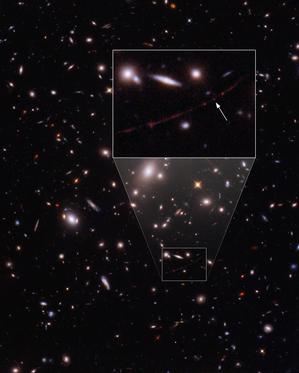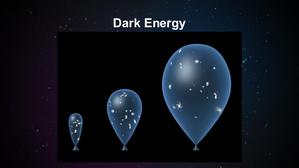Glossarbegriffe: Gravitationslinse
Description: Objekte mit Masse können den Weg des Lichts, das in ihrer Nähe vorbeizieht, krümmen. Dieser von Einsteins Allgemeiner Relativitätstheorie vorhergesagte Effekt wurde zum ersten Mal während der Sonnenfinsternis von 1919 beobachtet: Damals wurde gemessen, wie das Licht mehrerer Sterne von der Sonne abgelenkt wurde. Prinzipiell kann jedes Objekt mit Masse den Weg von Licht auf diese Weise beeinflussen. Als Gravitationslinse bezeichnet man aber üblicherweise nur Objekte, bei denen diese Ablenkung signifikant ist: Gravitationslinseneffekte treten vor allem bei sehr massereichen Objekten wie Galaxien oder Galaxienhaufen auf. Wenn Beobachter auf der Erde auf ein weit entferntes Objekt blicken, dessen Licht auf diese Weise (durch die "Linse") abgelenkt wird, erscheint das Objekt verzerrt. Diese Verzerrung bedeutet immer eine Konzentration des Lichts, wodurch wir normalerweise schwache Hintergrundobjekte besser sehen können. Wenn die Linse selbst genügend Masse in einem relativ kleinen Bereich hat, entstehen mehrere Bilder desselben Hintergrundobjekts, deren Licht den Beobachter jeweils zu unterschiedlichen Zeiten erreicht. Die Messung dieser unterschiedlichen Ankunftszeiten (zeitliche Verzögerung) ist eine der besten Methoden, um den Wert der Hubble-Konstante auf extragalaktischen Skalen zu bestimmen. Mehrere Bilder einer Linse ermöglichen es uns andererseits mithilfe von Modellen die Masse der Linse genau zu bestimmen. Das ist eine sehr nützliche Methode für Galaxien, die für Galaxienhaufen sogar noch wichtiger ist.
Zugehörige Glossarbegriffe:
See this term in other languages
Term and definition status: The original definition of this term in English have been approved by a research astronomer and a teacher The translation of this term and its definition is still awaiting approval
The OAE Multilingual Glossary is a project of the IAU Office of Astronomy for Education (OAE) in collaboration with the IAU Office of Astronomy Outreach (OAO). The terms and definitions were chosen, written and reviewed by a collective effort from the OAE, the OAE Centers and Nodes, the OAE National Astronomy Education Coordinators (NAECs) and other volunteers. You can find a full list of credits here. All glossary terms and their definitions are released under a Creative Commons CC BY-4.0 license and should be credited to "IAU OAE".
If you notice a factual or translation error in this glossary term or definition then please get in touch.
Zugehörige Medien
A gravitational lens magnifies one of the first stars
Bildnachweis: NASA, ESA, B. Welch (JHU), D. Coe (STScI), A. Pagan (STScI) credit link
License: CC-BY-4.0 Creative Commons Namensnennung 4.0 International (CC BY 4.0) icons
Related Activities
Dark matter & dark energy (Part 2) – Understanding the nature of dark matter and dark energy
astroEDU educational activity (links to astroEDU website) Description: Let's investigate the nature of dark matter and energy with gravitational lensing!
License: CC-BY-4.0 Creative Commons Namensnennung 4.0 International (CC BY 4.0) icons
Tags:
Experiment
, Invisible
Age Ranges:
12-14
, 14-16
, 16-19
, 19+
Education Level:
Informal
, Middle School
Areas of Learning:
Guided-discovery learning
, Interactive Lecture
, Modelling
, Problem-solving
Costs:
Medium Cost
Duration:
45 mins
Group Size:
Group
Skills:
Constructing explanations
, Developing and using models
, Engaging in argument from evidence










